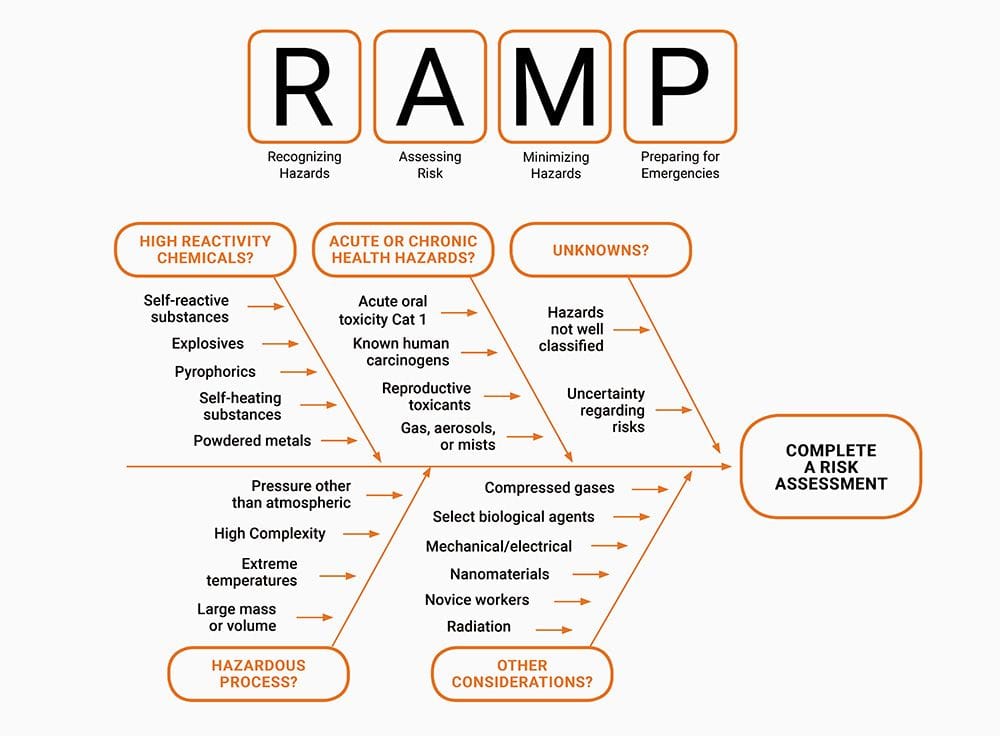Safety is a core value of the American Chemical Society and an integral part of the overall research process. In the final part of this three-part series, we cover frequently asked questions and highlight additional ACS chemical safety resources.

Frequently Asked Questions
There will undoubtedly be many questions that will arise when considering how to best structure your safety statement within the context of your manuscript.
Here, we’ve provided additional clarification for commonly asked questions when authors seek to meet the ACS requirement to “emphasize any unexpected, new, and/or significant hazards or risks associated with the reported work.”
How do I determine what classifies as a “significant” hazard or risk?
A “significant or unusual” hazard is anything that presents a major risk or requires preventative measures beyond those commonly expected to be present in a laboratory setting. Any hazards that fall within the Globally Harmonized System of Classification and Labelling of Chemicals (GHS) Category 1 classification should always be noted. Even with novel or less hazardous materials, it is always best to use discretion, perform a comprehensive risk assessment, and note any potential risks associated with your processes. It will never hurt to be as thorough as possible during this reporting step!
Which section of my manuscript should include the safety statement?
To maximize visibility and utility, it is recommended to insert your safety statement in the Experimental Materials or Methods section of your manuscript. It is also a good idea to reiterate or expand upon your safety statement in the Supporting Information section, especially if it includes any details and context related to the author’s specific experience with the hazardous materials or procedures used.
At what point in the research process should I perform a risk assessment?
The risk assessment is the second step of RAMP, and it should be conducted after you’ve identified any hazards and before you begin your experimental methods. As mentioned in Part 2 of this series, your risk assessment will be the most complex step of RAMP, but it will help inform the necessary components of your safety statement as you begin writing.

Does my safety statement count towards my overall word limit?
If your statement is 100 words or fewer, it will not contribute towards your final word count. Longer summaries will be handled differently by each individual journal—you can learn more about length requirements by either consulting the journal’s Author Guidelines or contacting the Editor-in-Chief’s office.
Additional Safety Resources
ACS Division of Chemical Health and Safety
The ACS Division of Chemical Health and Safety is a technical division of ACS and a premier source for advancing best chemical and health safety practices through authoritative technical resources and mentorship. With nearly 2,000 members, the Division provides educational tools, training, and support for chemists, educators, safety professionals, and the public.
For more information or to become a member of the Division, contact membership@dchas.org.
ACS Committee on Chemical Safety
The ACS Committee on Chemical Safety (CCS) was established in 1963 with the vision of fostering “a scientific community that embraces safety in all activities of the chemistry enterprise.” Through collaborative partnerships, peer-reviewed publications, tools for professional and educational use, and advisory support for other ACS committees and members, CCS is leading resource for promoting chemical and laboratory safety throughout the Society.
Visit the CCS website to learn more about the Committee and its members, explore resources, and browse upcoming events.
ACS Chemical Health & Safety
The journal ACS Chemical Health & Safety is a global platform for ensuring that all members of the chemical enterprise receive access to new research, safety information, regulatory updates, effective chemical hygiene practices, and hazard assessment tools. The Journal publishes high-quality articles and research appropriate for scientists, EH&S industry professionals, educators, and others who work in settings that contain chemicals or hazardous materials.
If you would like to learn more or are interested in publishing in ACS Chemical Health & Safety, visit the Journal’s website to browse the latest issue or view manuscript criteria.
ACS Center for Lab Safety
Part of the ACS Institute, the ACS Center for Lab Safety is a one-stop shop for educational resources supporting safe, ethical, and sustainable chemistry practices. From grade school classrooms to industrial laboratories, you will find training tools and learning opportunities—both in person and online— that aim to strengthen ACS’s Core Value of Safety through education.
Further Reading
SAFETY INFORMATION IN JOURNAL ARTICLES: THE COMPLETE SERIES
Part 1: The Necessity of Communication
Part 2: Tips for a Well-Written Safety Statement
Part 3: FAQs and Additional Resources
VIRTUAL AND SPECIAL ISSUES
Process Safety from Bench to Pilot to Plant
ARTICLES FROM ACS PUBLICATIONS JOURNALS
Safety Data Sheets: Challenges for Authors, Expectations for End-Users
Anne DeMasi, Harry Elston, and Neal Langerman
ACS Chem. Health Saf. 2022, 29, 4, 369–377
The Ten Most Common Laboratory Safety Issues
Richard Palluzi
ACS Chem. Health Saf. 2022, 29, 1, 19–26
Peer Reviewed Methods/Protocols
Mary Beth Mulcahy
ACS Chem. Health Saf. 2022, 29, 1, 1–2
Toxicity of Metal Compounds: Knowledge and Myths
Ksenia S. Egorova and Valentine P. Ananikov*
Organometallics 2017, 36, 21, 4071–4090
How Dangerous Is Too Dangerous? A Perspective on Azide Chemistry
Daniel S. Treitler* and Simon Leung
J. Org. Chem. 2022, 87, 17, 11293–11295
A Need for Caution in the Preparation and Application of Synthetically Versatile Aryl Diazonium Tetrafluoroborate Salts
James D. Firth and Ian J. S. Fairlamb*
Org. Lett. 2020, 22, 18, 7057–7059
ADDITIONAL SAFETY RESOURCES
Periodic Table of Safety Elements
ACS Style Sheet for Writing Safety Statements
ACS Essentials of Lab Safety for General Chemistry: A Course
CHAS Workshops 2022-2023
CCS Publications and Resources
ACS Guide to Scholarly Communication: Communicating Safety Information
